
|
Public Safety Canada Portfolio Report: Victim Complaint Resolution Mechanisms
|
This report summarizes complaints received and responded to within the 2021-2022 fiscal year by PS’s National Office for Victims (NOV), as well as the following PS Portfolio agencies who all have responsibilities to victims under the CVBR: the Correctional Service Canada (CSC), the Parole Board of Canada (PBC), the Royal Canadian Mounted Police (RCMP) and the Canada Border Services Agency (CBSA).
| 2024-04-29 |

|
2022 Corrections and Conditional Release Statistical Overview
|
This document provides a statistical overview of corrections and conditional release within a context of trends in crime and criminal justice.
| 2024-03-19 |

|
Reading the 2022 Corrections and Conditional Release Statistical Overview (CCRSO)
|
This resource is designed to provide some context and clarity around select key data literacy topics and terminology relevant to the 2022 Corrections and Conditional Release Statistical Overview (CCRSO).
| 2024-03-19 |

|
Structured Intervention Unit Implementation Advisory Panel 2022 to 2023 Annual Report
|
Second Annual Report (2022 to 2023) of the Structured Intervention Units Implementation Advisory Panel.
| 2024-03-11 |

|
Federal Framework to Reduce Recidivism Implementation Plan 2023-25
|
Developed in consultation with a diverse array of stakeholders, the Framework outlined five priority themes key to the successful reintegration of individuals: housing, education, employment, health, and positive support networks.
| 2023-11-15 |

|
Structured Intervention Units Implementation Advisory Panel Update #3-2023
|
In this update, we examine several issues related to Indigenous prisoners' experiences with Correctional Service Canada's Structured Intervention Units established in 2019 as a replacement for segregation.
| 2023-05-24 |
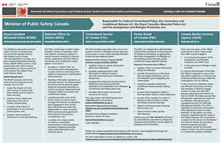
|
Overview of Federal Corrections and Criminal Justice - Victim-Centred Information and Assistance
|
Overview of Federal Corrections and Criminal Justice - Victim-Centred Information and Assistance
| 2023-05-16 |

|
Transforming Community Supervision Through Evidence-Based Practice
|
This report explores the use of community supervision, its effectiveness, and what can be done to improve it.
| 2023-05-05 |

|
Research Summary: Transforming Community Supervision through Evidence-Based Practice
|
This summary explores the use of community supervision, its effectiveness, and what can be done to improve it.
| 2023-05-05 |
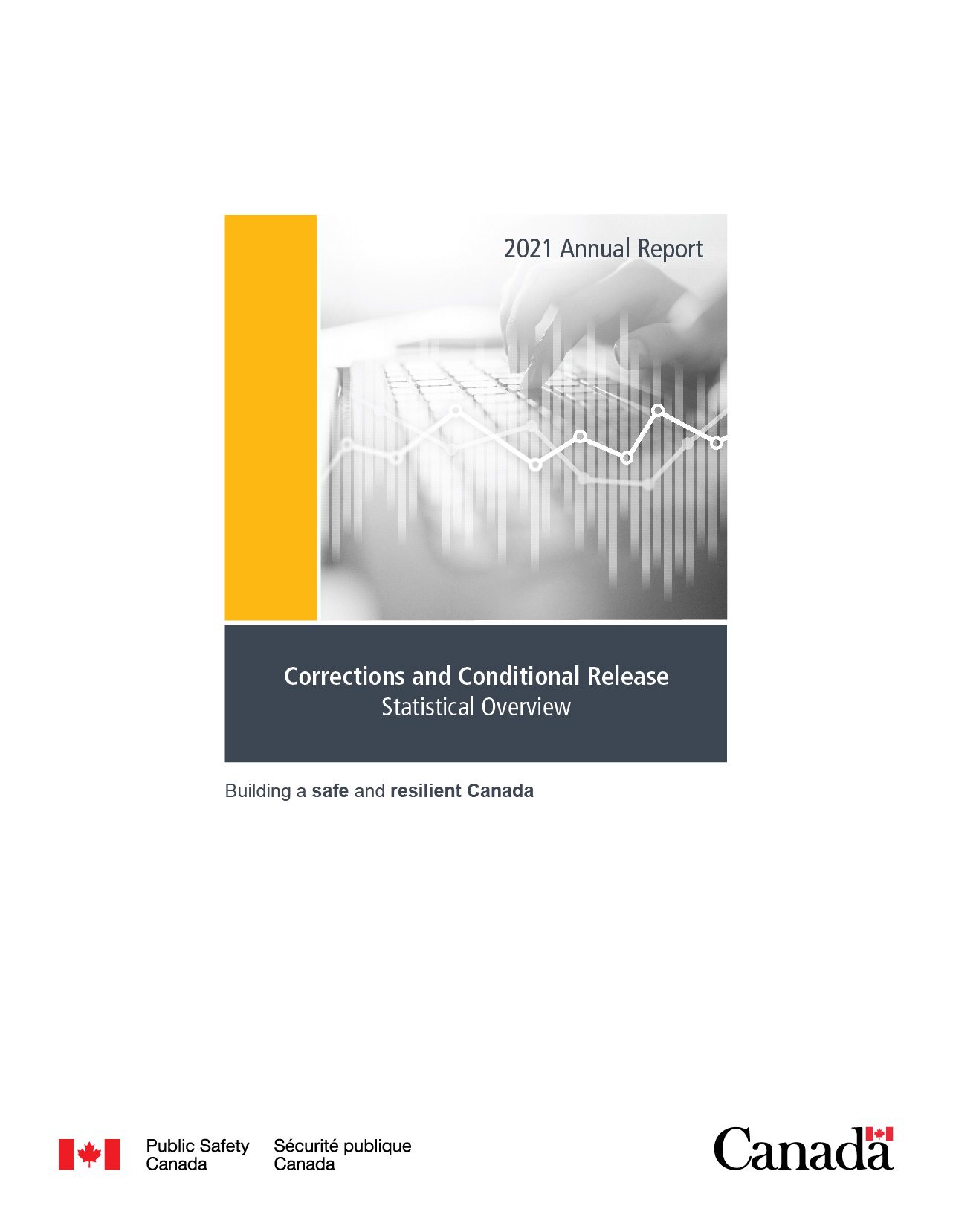
|
2021 Corrections and Conditional Release Statistical Overview
|
This document provides a statistical overview of corrections and conditional release within a context of trends in crime and criminal justice.
| 2023-03-20 |

|
Dynamic Risk Scales Decay Over Time: Evidence for Reassessment
|
This document is a study investigating how the predictive accuracy of two popular dynamic risk assessment tools for sexual offending, the ACUTE-2007 and the STABLE-2007, decay over time using samples of men under community supervision adjudicated for sexual offences.
| 2023-03-10 |

|
Research Summary: Dynamic Risk Scales Decay Over Time: Evidence for Reassessment
|
This document is a summary that examines the study to investigate how the predictive accuracy of two popular dynamic risk assessment tools for sexual offending, the AIGU-2007 and the STABLE-2007, decay over time using samples of men under community supervision adjudicated for sexual offences.
| 2023-03-10 |

|
Mental Health and the SIUs: An Update for the Structured Intervention Unit Implementation Advisory Panel
|
Isolation in prison is intimately intertwined with mental health issues. For decades, it has been well-established that almost all reputable research on this topic has concluded that being held in solitary conditions of confinement, especially for long periods of time, is harmful to prisoners' mental health.
| 2023-03-08 |

|
Evaluation of Risk Assessment Tools for Indigenous Individuals with a History of Sexual Crimes: A Response to Ewert case (2018)
|
This document examines how risk assessment tools for individuals with a history of sexual offences estimate the recidivism risk for Indigenous individuals, and whether they differ on risk-relevant characteristics compared to White individuals.
| 2023-02-24 |

|
Research Summary - Evaluation of Risk Assessment Tools for Indigenous Individuals with a History of Sexual Crimes: A Response to Ewert case (2018)
|
This document is a summary that examines how risk assessment tools for individuals with a history of sexual offences estimate the recidivism risk for Indigenous individuals, and whether they differ on risk-relevant characteristics compared to White individuals.
| 2023-02-24 |

|
Independent Oversight of Structured Intervention Units in Canada's Penitentiaries
|
An Update - Structured Intervention Unit Implementation Advisory Panel - 20 December 2022
| 2023-02-16 |

|
Automated Sequestering of Criminal Records: Parameters for a Canadian Approach
|
Automated Sequestering of Criminal Records (ASCR) is an automated program by which a criminal record would be kept separate and apart from other criminal records, at no cost and without an application by the individual, after they have completed their sentence and certain additional conditions are met, as required by legislation.
| 2022-11-29 |
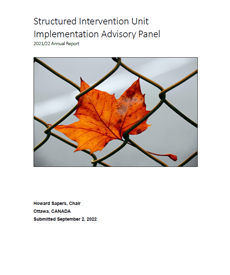
|
Structured Intervention Unit Implementation Advisory Panel 2021-22 Annual Report
|
The first Annual Report of the Structured Intervention Unit Implementation Advisory Panel concludes with recommendations to the Commissioner of the Correctional Service of Canada and advice to the Minister of Public Safety. The recommendations and advice address 14 key areas of concern regarding the operation of SIUs and the future of CSC oversight.
| 2022-10-28 |

|
Federal Framework to Reduce Recidivism
|
The Federal Framework to Reduce Recidivism is the Government of Canada's first step in putting together a plan that identifies crucial factors that impact why people reoffend and how to support safe and successful reintegration into the community.
| 2022-06-22 |

|
Sexual Coercion and Violence in Federal Corrections
|
In its 2019-2020 Annual Report, the Office of the Correctional Investigator (OCI) released a report on a national investigation into Sexual Coercion and Violence (SCV) in Canadian corrections. In this report, the OCI addressed two recommendations to the Minister of Public Safety, calling for the introduction of legislation that endorses a zero-tolerance approach to SCV and the designation of funds for a national prevalence study. The OCI also addressed recommendations to the Correctional Service of Canada (CSC) on this issue.
| 2022-05-30 |

|
Preliminary Observations of the Operation of Correctional Service of Canada's Structured Intervention Units
|
The Structured Intervention Unit (SIU) regime was established by legislation in 2019 as an attempt to respond to successful court challenges to the previous regime of “Administrative Segregation.”
| 2022-04-26 |

|
2020 Corrections and Conditional Release Statistical Overview
|
This document provides a statistical overview of corrections and conditional release within a context of trends in crime and criminal justice.
| 2022-02-11 |

|
Large-Scale Implementation and Evaluation of the Strategic Training Initiative in Community Supervision (STICS)
|
The current study evaluated the system-wide implementation of the Strategic Training Initiative in Community Supervision (STICS) across British Columbia (BC)'s Community Corrections Division.
| 2021-08-04 |

|
Research Summary - Large-Scale Implementation and Evaluation of the Strategic Training Initiative in Community Supervision (STICS)
|
The current study evaluated the system-wide implementation of the Strategic Training Initiative in Community Supervision (STICS) across British Columbia (BC)'s Community Corrections Division.
| 2021-08-04 |

|
Economic Outcomes of Canadian Federal Offenders
|
This report provides information on federal offenders' economic outcomes (for example, employment and income) up to an average of 14 years after their release into the community.
| 2021-04-08 |

|
Research Summary - Economic Outcomes of Canadian Federal Offenders: A Brief Overview
|
This summary provides an overview of the information on federal offenders' economic outcomes (for example, employment and income) up to an average of 14 years after their release into the community.
| 2021-04-08 |

|
Increasing the Use of Restorative Justice in Criminal Matters in Canada - Baseline Report
|
This document shares the results of a survey concerning baseline data on the use of restorative justice processes in the Canadian criminal justice sector.
| 2020-11-24 |

|
2019 Corrections and Conditional Release Statistical Overview
|
This document provides a statistical overview of corrections and conditional release within a context of trends in crime and criminal justice.
| 2020-10-16 |

|
National Victims Roundtable on the Right to Protection in Federal Corrections and Conditional Release
|
On February 14th and 15th, 2019, Public Safety Canada's (PS) National Office for Victims (NOV) met with victim stakeholders and non-governmental organizations to discuss the role of victims in the federal corrections and conditional release system, and their Right to Protection under the Canadian Victims Bill of Rights (CVBR).
| 2019-09-06 |

|
2018 Corrections and Conditional Release Statistical Overview
|
This document provides a statistical overview of corrections and conditional release within a context of trends in crime and criminal justice.
| 2019-08-19 |
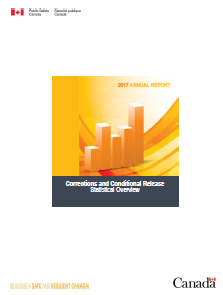
|
2017 Corrections and Conditional Release Statistical Overview
|
This document provides a statistical overview of corrections and conditional release within a context of trends in crime and criminal justice.
| 2018-09-10 |

|
Research Summary: A Meta-analysis of the Effectiveness of Culturally-relevant Treatment for Indigenous Offenders
|
Preliminary research supports the effectiveness of culturally-relevant programming with Indigenous offenders for reducing re-offending; however, higher quality research is needed to understand how cultural-relevance is related to program effectiveness.
| 2018-09-10 |

|
How to best predict sexual reoffending among sex offenders
|
The research summary is a study that examined how best to predict the risk to reoffend among sex offenders.
| 2018-05-01 |

|
Child Pornography Offenders: A Review
|
The research summary is a review of the current state of knowledge on child pornography offenders, to determine implications for practice, and to highlight areas that are relevant for future research.
| 2018-05-01 |

|
Helping Victims Prepare for the Release of a Federal Offender
|
This booklet provides steps you can take to protect yourself and your loved ones, and to help you feel safe and supported, when the offender who harmed you is being reintegrated into society.
| 2018-04-27 |
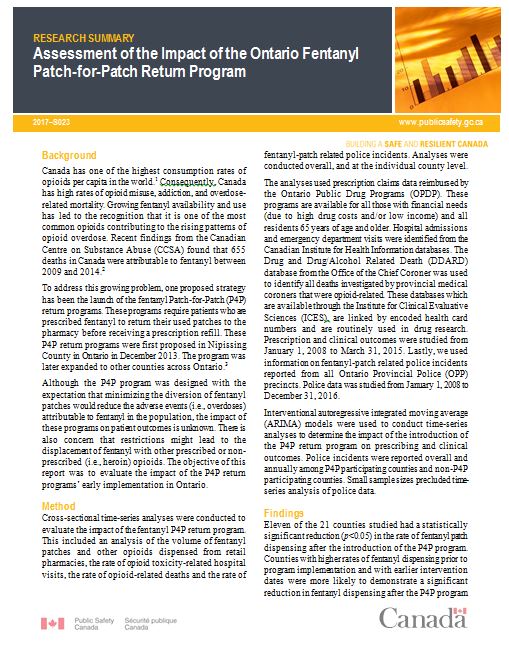
|
Assessment of the Impact of the Ontario Fentanyl Patch-for-Patch Return Program
|
This study evaluates the impact of the Patch-for-Patch programs implemented between February 2013 and April 2016. Cross-sectional time-series analyses were conducted to evaluate the impact of the program initiation on fentanyl dispensing, non-fentanyl opioid dispensing, opioid-related hospital visits and deaths, and fentanyl-related police incident.
| 2018-04-11 |

|
Research Summary - Offender Risk Assessment Practices Vary Across Canada
|
What exactly does it mean when a correctional agency assesses an offender to be high risk?
| 2018-03-27 |

|
Static-99R Coding Rules Revised – 2016
|
This manual comprises the third published version of the coding rules for Static-99R; a risk assessment tool designed to predict reoffending among individuals with sexual offences.
| 2017-12-19 |

|
2016 Corrections and Conditional Release Statistical Overview
|
This document provides a statistical overview of corrections and conditional release within a context of trends in crime and criminal justice.
| 2017-09-15 |
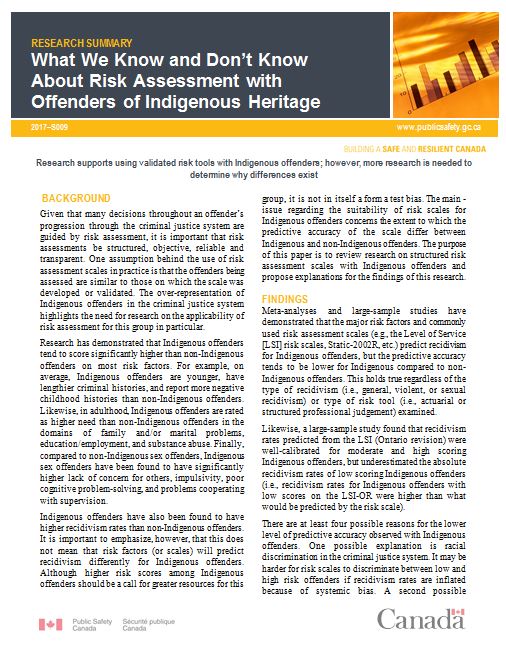
|
Research Summary - What We Know and Don't Know About Risk Assessment with Offenders of Indigenous Heritage
|
The purpose of this paper is to discuss the applicability of structured risk assessment scales with Indigenous offenders. This includes a brief overview of risk assessment and possible reasons why we may or may not expect risk scales to perform the same or differently with Indigenous offenders.
| 2017-08-08 |

|
What We Know and Don't Know About Risk Assessment with Offenders of Indigenous Heritage
|
The purpose of this paper is to discuss the applicability of structured risk assessment scales with Indigenous offenders. This includes a brief overview of risk assessment and possible reasons why we may or may not expect risk scales to perform the same or differently with Indigenous offenders.
| 2017-08-08 |

|
2015-2016 Evaluation of the Grants Program to National Voluntary Organizations
|
Evaluation supports accountability to Parliament and Canadians by helping the Government of Canada to report on the results achieved with the resources invested in programs.
| 2016-11-10 |

|
2015 Corrections and Conditional Release Statistical Overview
|
This document provides a statistical overview of corrections and conditional release within a context of trends in crime and criminal justice.
| 2016-04-21 |

|
2014 Corrections and Conditional Release Statistical Overview
|
This document provides a statistical overview of corrections and conditional release within a context of trends in crime and criminal justice.
| 2015-11-13 |

|
Predictors of Sexual Recidivism: An Updated Meta-Analysis 2004-02
|
This quantitative review examined the research evidence concerning recidivism risk factors for sexual offenders. A total of 95 different studies were examined, involving more than 31,000 sexual offenders and close to 2000 recidivism predictions. The results confirmed deviant sexual interests and antisocial orientation as important predictors of sexual recidivism.
| 2014-01-01 |
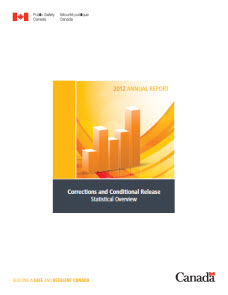
|
2012 Corrections and Conditional Release Statistical Overview
|
This document provides a statistical overview of corrections and conditional release within a context of trends in crime and criminal justice. A primary consideration in producing this overview was to present general statistical information in a "user friendly" way that will facilitate understanding by a broad audience.
| 2013-08-13 |

|
Risk and Mentally Disordered Offenders
|
Are the risk factors for mentally disordered offenders different than for non-disordered offenders?
| 2013-07-31 |

|
National Joint Committee of Senior Criminal Justice Officials Annual Report 2012-2013
|
This report highlights the key activities and achievements of the NJC and its regional committees (Atlantic, Quebec, Ontario, Prairies, and Pacific regions).
| 2013-07-08 |

|
Arrest Without Warrant: Handbook for Front-line Peace Officers 2013
|
This instructive handbook is an initiative of Public Safety Canada and the National Joint Committee of Senior Criminal Justice Officials (NJC) in response to newly introduced amendments to the Corrections and Conditional Release Act (CCRA) brought about by the Safe Streets and Communities Act.
| 2013-06-20 |

|
Screening Volunteers for the Risk of Child Sexual Abuse
|
How can volunteer organizations identify applicants at risk for committing child sexual abuse?
| 2013-05-01 |

|
Attitudes supportive of sex offending predict recidivism
|
Do attitudes supportive of sex offending predict recidivism among sexual offenders?
| 2013-03-01 |

|
The Prediction of Risk for Mentally Disordered Offenders: A Quantitative Synthesis 2013-01
|
Mentally disordered offenders (MDOs) pose a significant challenge for forensic and correctional staff charged with managing them in a safe and humane manner.
| 2013-01-01 |

|
Predicting recidivism with aboriginal offenders
|
Do the Central Eight risk/need factors predict recidivism with Aboriginal offenders?
| 2013-01-01 |

|
"What Works" in Drug Treatment Courts
|
How do the principles of effective correctional intervention apply in drug treatment courts?
| 2012-11-01 |

|
The Screening Handbook 2012 Edition
|
The 2012 Edition of The Screening Handbook was created to provide organizations with up-to-date information, tools, and resources to support comprehensive, ongoing screening policies and practices. It is important to understand that "the primary issue related to screening is what people are called upon to do, for whom, and under what circumstances, not whether they are paid or not paid for their efforts." While the material may be useful for organizations engaging paid employees, interns, placement students, and community service participants, the intended purpose is to build awareness and capacity for screening volunteers.
| 2012-10-17 |

|
Cognitive-Behavioural Interventions in Community Supervision
|
How well do community supervision officers target procriminal attitudes/cognitions in one-on-one sessions with their clients?
| 2012-09-01 |

|
National Joint Committee of Senior Criminal Justice Officials - Annual Report 2011-2012
|
This report highlights the key activities and achievements of the NJC and its regional committees (Atlantic,Quebec, Ontario, Prairie, and Pacific regions).
| 2012-08-14 |

|
Risk Assessment For Aboriginal Sex Offenders
|
Do the same risk factors apply to Aboriginal and non-Aboriginal sex offenders?
| 2012-07-01 |

|
Marginalized: The Aboriginal Women's experience in Federal Corrections
|
Marginalized: The Aboriginal Women's experience in Federal Corrections
| 2012-05-23 |

|
Assessing the Risk of Gang Members
|
Do gang members vary in their risk to commit crime?
| 2012-05-01 |

|
Predicting Recidivism with Street Gang Members
|
The objective of this research is to examine the applicability of the LS/CMI (Andrews, Bonta, & Wormith, 2004) to gang members and to identify specific criminogenic needs profiles compared to non-gang offenders.
| 2012-04-17 |

|
Combining Risk Assessment Tools
|
How should we combine the results of different offender risk assessment tools?
| 2012-03-01 |

|
From Case Management to Change Agent: The Evolution Of 'What Works' Community Supervision
|
In this article, we define what cognitive-behaviourism looks like in a criminal justice context and how it can be used to maximize the impact of community supervision. Through the amalgamation of cognitive-behavioural techniques and risk/need information, we propose the use of a theoretically and empirically-based framework (i.e., the STICS Action Plan) to assist community supervision officers in planning, prioritizing and effectively achieving change with their clients.
| 2012-01-31 |

|
2011 Corrections and Conditional Release Statistical Overview
|
This document provides a statistical overview of corrections and conditional release within a context of trends in crime and criminal justice. A primary consideration in producing this overview was to present general statistical information in a "user friendly" way that will facilitate understanding by a broad audience.
| 2012-01-19 |

|
Effective Prison Management
|
What steps can be taken to more effectively manage prisons?
| 2012-01-01 |
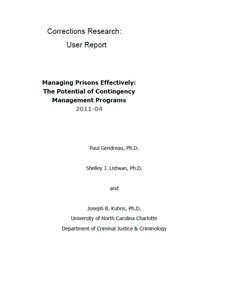
|
Managing Prisons Effectively: The Potential of Contingency Management Programs
|
This study draws attention to a long forgotten prison treatment literature known as contingency management (e.g., token economies) which has the potential to meet the goals of an "accountability" management perspective. The contingency management (CM) literature was reviewed to assess its potency for improving inmates' performance (e.g., prison adjustment, educational/work skills) and to generate a list of principles nominated by experts in the area for managing CM programs effectively.
| 2011-09-14 |

|
Strengths And Human Needs In Offender Rehabilitation
|
What is the role played by strengths and basic human needs in the rehabilitation of offenders?
| 2011-09-01 |

|
The Treatment of Incarcerated Mentally Disordered Women Offenders: A Synthesis of Current Research
|
This synthesis of the research evidence in relation to the treatment of mentally disordered women offenders is prompted by recent reviews of correctional practice in the Canadian federal correctional system, and the growing awareness of the impact research can have on programs for women within the correctional system.
| 2011-08-10 |
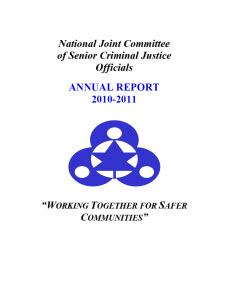
|
National Joint Committee of Senior Criminal Justice Officials Annual Report 2010-2011
|
This report describes the main activities and achievements of the NJC and its regional committees (the Atlantic, Quebec, Ontario, Prairies and Pacific regions).
| 2011-07-25 |
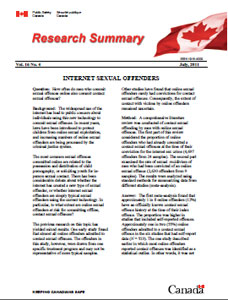
|
Internet Sexual Offenders
|
How often do men who commit sexual offences online also commit contact sexual offences?
| 2011-07-01 |
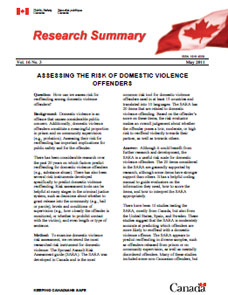
|
Assessing The Risk Of Domestic Violence Offenders
|
How can we assess risk for reoffending among domestic violence offenders?
| 2011-05-01 |

|
The RRASOR, Static-99R and Static-2002R All Add Incrementally to the Prediction of Recidivism among Sex Offenders
|
The current study examined the predictive accuracy and incremental validity of three risk assessment scales (RRASOR, Static-99R, and Static2002R) in twenty distinct samples of sex offenders (N = 7,491).
| 2011-03-09 |

|
Assessing the Risk of Older Sex Offenders: Developing the Static-99R and Static-2002R
|
The current study aimed to develop a revised scoring system for two risk assessment tools (Static-99 and Static-2002) that would more accurately describe older offenders' risk of recidivism.
| 2011-03-02 |

|
Addressing the Needs of Offenders
|
What offender needs should be addressed by treatment programs?
| 2011-03-01 |

|
Measuring Crime in Canada
|
How are statistics regarding the criminal justice system in Canada gathered and reported?
| 2011-01-01 |

|
2010 Corrections and Conditional Release Statistical Overview
|
This document provides a statistical overview of corrections and conditional release within a context of trends in crime and criminal justice. A primary consideration in producing this overview was to present general statistical information in a "user friendly" way that will facilitate understanding by a broad audience.
| 2010-12-31 |

|
Giving Meaning to Risk Factors
|
Why do risk factors predict recidivism?
| 2010-11-01 |

|
Ensuring the integrity of effective community supervision
|
How can correctional agencies ensure the integrity of effective community supervision?
| 2010-09-01 |

|
Fetal Alcohol Spectrum Disorder and the Criminal Justice System
|
The purpose of this bibliography is to provide sources of research and documentation that focus on justice and medical related issues as they pertain to FASD.
| 2010-07-20 |
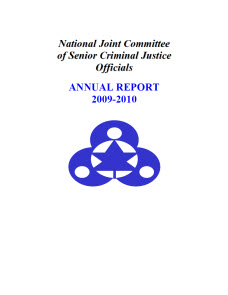
|
National Joint Committee of Senior Criminal Justice Officials Annual Report 2009-2010
|
This report describes the major activities and achievements of the NJC and its regional committees (Atlantic, Quebec, Ontario, Prairies and Pacific).
| 2010-07-20 |

|
The same risk factors predict most types of recidivism
|
Do the same risk factors apply to all types of offenders?
| 2010-07-01 |

|
Training in evidence-based community supervision
|
Can training improve the effectiveness of community supervision?
| 2010-05-01 |

|
The Strategic Training Initiative in Community Supervision: Risk-Need-Responsivity in the Real World 2010-01
|
In the present study, an RNR-based training program was developed and delivered to probation officers to assist in the direct supervision of offenders under a probation order.
| 2010-04-22 |

|
2010 Corrections and Conditional Release in Canada - A General Primer
|
2010 Corrections and Conditional Release in Canada - A General Primer
| 2010-03-30 |

|
Current Practices in Canadian Sexual Abuser Treatment Programs: The Safer Society 2009 Survey
|
This report is a summary of the Canadian findings of the 2009 Safer Society Survey: Current Practices and Emerging Trends in Sexual Abuser Management (McGrath, Cumming, Burchard, Zeoli, & Ellerby, 2010).
| 2010-03-30 |
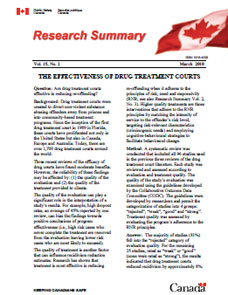
|
The Effectiveness of Drug Treatment Courts
|
Are drug treatment courts effective in reducing re-offending?
| 2010-03-01 |

|
Restorative justice's impact on participant health
|
Is restorative justice good for participants' health?
| 2010-01-01 |

|
The Investigation, Prosecution and Correctional Management of High-Risk Offenders: A National Guide
|
This guide has been prepared to provide police, prosecution, correctional and other criminal justice officials with an overview of the Criminal Code provisions designed to respond to sexual predators and other high-risk offenders.
| 2009-12-06 |

|
Soccer Moms are Part of the Solution "A Cost-Benefit Analysis of a Volunteer-Based Gang Prevention Initiative"
|
The research presented here begins with a case study of community mobilization that took place in Edmonton, Alberta in 2008.
| 2009-12-01 |

|
Drug Treatment Courts: A Quantitative Review of Study and Treatment Quality 2009-04
|
The effectiveness of drug courts has been debated in regards to two main factors: (1) study quality and (2) treatment quality. The current study examined these two factors. Study quality was examined using the Collaborative Outcome Data Committee Guidelines (CODC), and treatment quality was assessed by evaluating adherence to the principles of Risk-Need-Responsivity (RNR). Using the CODC Guidelines, studies were rated as: "rejected", "weak", "good" or "strong" based on methodological quality.
| 2009-12-01 |

|
2009 Corrections and Conditional Release Statistical Overview
|
This document provides a statistical overview of corrections and conditional release within a context of trends in crime and criminal justice. A primary consideration in producing this overview was to present general statistical information in a "user friendly" way that will facilitate understanding by a broad audience.
| 2009-12-01 |

|
Coding Rules for Static-2002
|
Static-2002 is an actuarial risk tool for evaluating the risk of sexual and violent recidivism among adult male sexual offenders (Hanson & Thornton, 2003). Like Static-99, Static-2002 can be used by a wide range of evaluators (e.g., psychologists, probation officers, psychiatrists, therapists) using commonly available criminal history information. Static-2002 predicts sexual, violent, and any recidivism as well as other actuarial risk tools commonly used with sexual offenders (Hanson & Morton-Bourgon, 2009) and slightly better than Static-99 (Hanson, Helmus, & Thornton, in press; Helmus, 2007).
| 2009-12-01 |

|
Common Ground - An Examination of Similarities between Black & Aboriginal Communities
|
Common Ground - An Examination of Similarities between Black & Aboriginal Communities
| 2009-11-26 |

|
Community Mobilisation Dialogue with Aboriginal Communities
|
The objective of the gatherings was to dialogue with a cross section of First Nations (Ojibwe, Mi'kmaq, Dene, Blackfoot and Kwakitutl) and urban Aboriginal groups about community mobilisation - how it is approached within their regions, the cultural context, and the impact that traditional and cultural approaches have on community mobilisation. A number of common themes were identified.
| 2009-11-01 |

|
The development of aboriginal chronic offending
|
Do Aboriginal offenders follow a similar path to chronic offending as Non-Aboriginal offenders?
| 2009-11-01 |

|
Restorative Justice's Impact on Participants' Psychological and Physical Health 2009-03
|
This study utilized a quasi-experimental, repeated-measures design to assess changes in psychological and physical health in 92 participants (50 victims and 42 offenders) who experienced a restorative justice process. Results indicated that the majority of participants did experience positive changes from pre-program to post-program. Future research directions and limitations are discussed.
| 2009-11-01 |

|
Risk Assessment Decisions for Violent Political Extremism 2009-02
|
Approaches to risk assessment for violence are described in the document. These include unstructured clinical judgment, actuarial approaches and structured professional judgment (SPJ). Unstructured approaches have been criticized for not demonstrating high validity or good inter-rater reliability.
| 2009-10-01 |

|
A Meta-Analysis of the Effectiveness of Treatment for Sexual Offenders: Risk, Need, and Responsivity 2009-01
|
The current review examined whether the principles associated with effective treatments for general offenders (Risk–Need–Responsivity: RNR) also apply to sexual offender treatment.
| 2009-10-01 |

|
National Joint Committee of Senior Criminal Justice Officials Annual Report 2008-2009
|
This report describes the major activities and achievements of the NJC and its regional committees (Atlantic, Quebec, Ontario, Prairies and Pacific).
| 2009-09-25 |
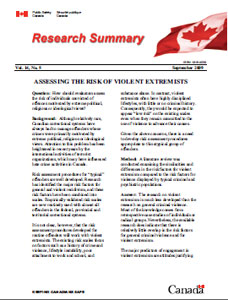
|
Assessing the risk of violent extremists
|
How should evaluators assess the risk of individuals convicted of offences motivated by extreme political, religious or ideological views?
| 2009-09-01 |

|
What To Do With Low Risk Offenders?
|
Do low risk offenders need treatment?
| 2009-07-01 |

|
Risk Communication for Offenders
|
How should we report the recidivism risk of offenders?
| 2009-05-01 |

|
Translating 'What Works' into Sustainable Everyday Practice: Program Design, Implementation and Evaluation 2009-05
|
In this report, we describe the challenges and issues that should be addressed when trying to bring research to the real world of community supervision faced by probation officers and we evaluate our efforts to overcome these challenges through STICS.
| 2009-05-01 |

|
What Works For Sexual Offenders?
|
Do the principles of effective intervention for general offenders also apply to treatments for sexual offenders?
| 2009-03-01 |
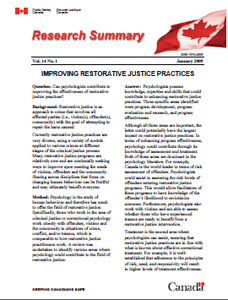
|
Improving Restorative Justice Practices
|
Can psychologists contribute to improving the effectiveness of restorative justice practices?
| 2009-01-01 |

|
2008 Corrections and Conditional Release Statistical Overview
|
This document provides a statistical overview of corrections and conditional release within a context of trends in crime and criminal justice. A primary consideration in producing this overview was to present general statistical information in a "user friendly" way that will facilitate understanding by a broad audience.
| 2008-12-01 |
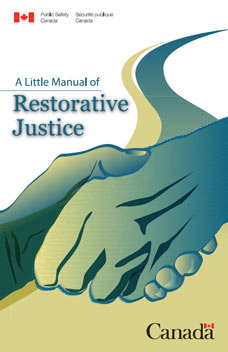
|
A Little Manual of Restorative Justice
|
The little manual wants to put into your hands a basic training tool. The themes addressed in the various modules are themes that the writers\practitioners have found useful in seeking to educate communities about restorative justice and engage citizens in a deeper reflection about the criminal justice system.
| 2008-12-01 |

|
Best Practice Guidelines for Screening Volunteers
|
This booklet outlines the essential steps for screening persons applying to work as volunteers. Organizations should consult the resources at the end of this booklet for more detailed information on how to conduct volunteer screening.
| 2008-12-01 |

|
Community Supervision: Balancing Compliance With Treatment
|
Community Supervision: Balancing Compliance With Treatment
| 2008-09-01 |

|
Is Denial Always A Problem For Sexual Offenders?
|
What is the relationship between denial and recidivism among sexual offenders?
| 2008-07-01 |
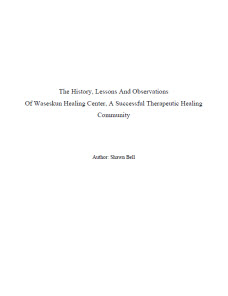
|
The History, Lessons And Observations Of Waseskun Healing Center, A Successful Therapeutic Healing Community
|
This study of the Waseskun Healing Center, encouraged by CSC's recent attempts to translate the Healing Lodge's principles and teachings into the mainstream penitentiary system, set out to examine the workings of Waseskun in order to determine what makes a successful therapeutic healing community.
| 2008-06-11 |
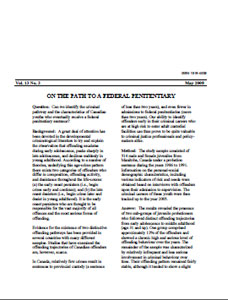
|
On The Path To A Federal Penitentiary
|
Can we identify the criminal pathway and the characteristics of Canadian youths who eventually receive a federal penitentiary sentence?
| 2008-05-01 |

|
Advances in offender risk assessment
|
What progress is being made in the risk assessment of criminal offenders?
| 2008-03-01 |

|
The accuracy of risk prediction for intimate partner violence
|
How well can risk assessments predict spousal assault recidivism?
| 2008-01-01 |
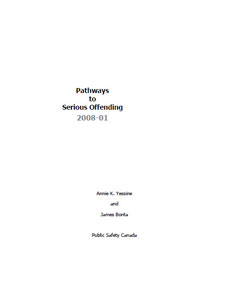
|
Pathways to Serious Offending 2008-01
|
The purpose of this study was to contribute to the growing body of criminological research on the developmental course of crime and expand its scope in various ways.
| 2008-01-01 |

|
ARCHIVE - NJC Bylaws
|
ARCHIVE - NJC Bylaws
| 2007-12-11 |

|
ARCHIVE - Statutes of the National Joint Committee of Senior Criminal Justice Officials
|
ARCHIVE - Statutes of the National Joint Committee of Senior Criminal Justice Officials
| 2007-12-11 |

|
Assessing the risk of sexual offenders on community supervision: The Dynamic Supervision Project
|
Sexual offenders do great societal damage causing justifiable public concern.
| 2007-12-02 |

|
2007 Corrections and Conditional Release Statistical Overview
|
This document provides a statistical overview of corrections and conditional release within a context of trends in crime and criminal justice. A primary consideration in producing this overview was to present general statistical information in a "user friendly" way that will facilitate understanding by a broad audience.
| 2007-12-01 |

|
Principles of Effective Offender Rehabilitation
|
What are the characteristics of effective offender treatment?
| 2007-11-01 |

|
The Community Solution to Gang Violence: A Collaborative Community Process and Evaluation Framework
|
This paper provides a model for viewing the work of comprehensive community initiatives, details the process and practice involved in mobilizing and engaging the community to address the issue of gangs, and outlines the evaluation framework used to measure the effectiveness and impact of a community-based and driven approach to prevent youth involvement in gangs.
| 2007-10-12 |

|
Supervising sexual offenders in the community
|
How can community supervision officers tell whether sexual offenders are at risk for reoffending?
| 2007-09-01 |
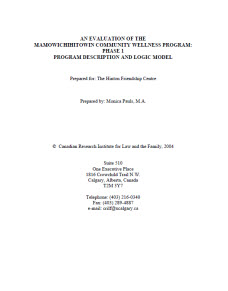
|
An Evaluation of the Mamowichihitowin Community Wellness Program
|
The purpose of this research project was to conduct the first phase of an evaluation of the Mamowichihitowin Community Wellness Program (MCWP) located in Hinton, Alberta.
| 2007-08-16 |

|
Reducing delinquency through family intervention
|
Can family therapy reduce delinquent behaviour?
| 2007-07-01 |

|
The Validity of Risk Assessments for Intimate Partner violence: A Meta-Analysis 2007-07
|
This meta-analysis reviews the predictive accuracy of different approaches and tools that are used to assess the risk of recidivism for male spousal assault offenders.
| 2007-07-01 |

|
Risk-need-responsivity model for offender assessment and rehabilitation 2007-06
|
This paper summarizes the role of the principles in the development of risk assessment instruments. It also explains why some interventions work and others do not.
| 2007-06-01 |
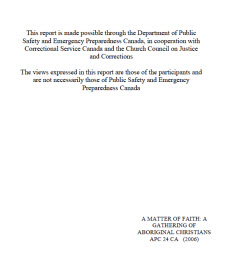
|
A Matter of Faith: a Gathering of Aboriginal Christians
|
This report presents a selection of the wide-ranging views put forward at the Gathering.
| 2007-05-29 |

|
Predicting violent recidivism
|
How well can risk assessment instruments predict violent recidivism?
| 2007-05-01 |

|
Assessing the Utility of Risk Assessment Tools and Personality Measures in the Prediction of Violent Recidivism for Adult Offenders 2007-04
|
The objective of the current study was to conduct a meta-analytic evaluation of the relative utility of risk instruments and other psychological measures as a means of informing the standards of practice for conducting violent risk assessments.
| 2007-04-01 |

|
The Collaborative Outcome Data Committee's Guidelines for the evaluation of sexual offender treatment outcome research
|
The objective of the current study was to conduct a meta-analytic evaluation of the relative utility of risk instruments and other psychological measures as a means of informing the standards of practice for conducting violent risk assessments.
| 2007-04-01 |

|
An Investigation into the Formation and Recruitment Processes of Aboriginal Gangs in Western Canada
|
This report provides a brief literature review of current gang research, including the incorporation of information from documents produced by agencies that work with gang-involved youth.
| 2007-03-19 |

|
Evaluating offender rehabilitation programs
|
How can we tell whether interventions with offenders reduce recidivism?
| 2007-03-01 |

|
Sexual Offender Treatment Outcome Research: CODC Guidelines for Evaluation
|
This document is intended for those seriously interested in research on the effectiveness of treatment for sexual offenders.
| 2007-03-01 |

|
The accuracy of risk prediction for sexual offenders
|
How should we assess the recidivism risk of sexual offenders?
| 2007-01-01 |

|
Restorative justice and offender treatment
|
Can offender treatment services improve the effectiveness of restorative justice interventions?
| 2006-11-01 |

|
Spousal Abuse Counseling Program - Rankin Inlet Manual for Counselors
|
This manual should be considered a tool to be used to guide the counselor in the delivery of group counseling.
| 2006-10-27 |

|
Risk factors for Aboriginal offenders
|
Are risk factors for criminal behaviour similar for Aboriginal and non-Aboriginal offenders?
| 2006-09-01 |

|
Screening for positions of trust with children
|
How can child service organizations limit the risk of sexual abuse?
| 2006-07-01 |

|
Recidivism rates of female sexual offenders
|
How often do female sexual offenders commit new crimes?
| 2006-05-01 |

|
Offender assessment and case management
|
How can we improve the link between offender assessment and case management?
| 2006-03-01 |

|
Sexually abusive juveniles
|
Are sexually abusive juveniles different from adult sex offenders?
| 2006-01-01 |

|
Risk assessment of male aboriginal offenders: A 2006 perspective
|
The purpose of this review was three-fold. First, the research on risk factors was reviewed to determine whether risk factors were similar for both Aboriginal and non-Aboriginal male offenders. Second, various risk assessment instruments were examined to determine how well they predicted risk for the male Aboriginal offenders. Third, different perspectives regarding risk assessment of male Aboriginal offenders were presented, commonalities between the views were identified, and recommendations were outlined.
| 2006-01-01 |

|
Identifying and tracking high-risk offenders
|
Is the National Flagging System (NFS) facilitating the early identification and the proper management of those offenders believed to be at a high risk to reoffend violently and/or sexually?
| 2005-11-01 |

|
Presentence Reports
|
How are Presentence Reports (PSR) used by the courts in sentencing?
| 2005-09-01 |

|
Restorative justice in cases of serious crime
|
Can a restorative justice approach be applied in cases of serious crime?
| 2005-07-01 |

|
Progress in violence risk assessment
|
What have we learned about evaluating the risk of future violence?
| 2005-05-01 |

|
The National Flagging System: Identifying and Responding to High-Risk, Violent Offenders 2005-04
|
The present research was aimed at empirically investigating the effectiveness of this policy initiative in identifying and responding to potentially dangerous offenders. Specifically, the profile of 256 flagged male offenders was compared with the profile of 97 known high-risk, violent offenders (i.e., Dangerous Offenders and Detention Failures).
| 2005-04-01 |

|
Effective correctional treatment
|
How much treatment is required to reduce reoffending?
| 2005-03-01 |

|
Presentence Reports in Canada 2005-03
|
The present study obtained the views of judges, probation officers, Crown attorneys and defence counsel on the use and value of PSRs. Participants were chosen from a site in each Canadian province and territory.
| 2005-03-01 |

|
Evaluation of the Collaborative Justice Project: A Restorative Justice Program for Serious Crime 2005-02
|
The goals of this evaluation were threefold: (1) to determine whether a restorative approach can be applied in cases of serious crime at the pre-sentence stage of the criminal justice system, (2) to determine whether the CJP successfully met its mandate and program goals, and (3) to expand the empirical base regarding restorative justice research.
| 2005-02-01 |

|
Accreditation standards for correctional programs
|
How can you tell whether a correctional program is likely to reduce reoffending?
| 2005-01-01 |

|
The Validity of Static-99 with Older Sexual Offenders 2005-01
|
Using data from 8 samples (combined size of 3,425 sexual offenders), the present study found that older offenders had lower Static-99 scores than younger offenders and that Static-99 was moderately accurate in estimating relative recidivism risk in all age groups.
| 2005-01-01 |
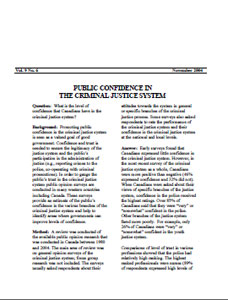
|
Public confidence in the criminal justice system
|
What is the level of confidence that Canadians have in the criminal justice system?
| 2004-11-01 |
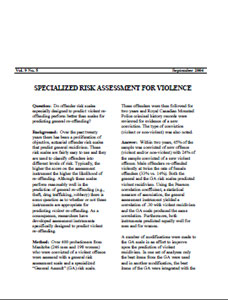
|
Specialized risk assessment for violence
|
Do offender risk scales especially designed to predict violent re-offending perform better than scales for predicting general re-offending?
| 2004-09-01 |
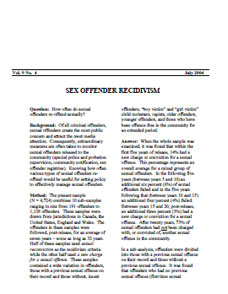
|
Sex offender recidivism
|
How often do sexual offenders re-offend sexually?
| 2004-07-01 |

|
Sexual abuse in the Catholic church
|
Are priests who abuse children different from other child molesters?
| 2004-05-01 |
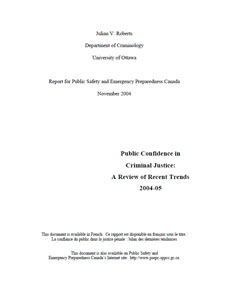
|
Public Confidence in Criminal Justice: A Review of Recent Trends 2004-05
|
The purpose of this report is to summarize recent trends regarding public confidence in criminal justice in Canada.
| 2004-05-01 |

|
Sex Offender Recidivism: A Simple Question
|
This study examines sexual recidivism, as expressed by new charges or convictions for sexual offences, using the data from 10 follow-up studies of adult male sexual offenders (combined sample of 4,724).
| 2004-05-01 |

|
Risk Assessment For General Assault And Partner Abusers 2004-04
|
The present report describes two studies that evaluated two specialized assessment tools: the Secondary Risk Assessment for General Assault (SRA-GA) and the Secondary Risk Assessment for Partner Abusers (SRA-PA).
| 2004-04-01 |

|
Predicting re-offending among sexual offenders
|
Which sexual offenders are most likely to re-offend?
| 2004-03-01 |

|
The supervision of offenders in the community
|
How are offenders supervised while they are in the community?
| 2004-03-01 |
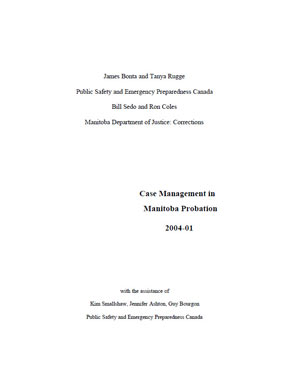
|
Case Management in Manitoba Probation 2004-01
|
In general, the study provides a snapshot of present practices in community supervision and points to areas of improvement. With training and support, probation officers can become more effective agents of change.
| 2004-01-01 |

|
Biidaaban: The Mnjikaning community healing model
|
The purpose of this research, therefore, is to provide a holistic picture of Biidaaban, the Mnjikaning Community Healing Strategy, in Mnjikaning First Nation that includes a description of the community, its healing process and its value to the community
| 2003-12-01 |

|
Cost-benefit analysis of a community healing process
|
Are Aboriginal community healing processes cost-effective alternatives to the traditional criminal justice process?
| 2003-11-01 |

|
Sexual offender empathy deficits
|
Do sexual offenders lack empathy for their victims?
| 2003-09-01 |
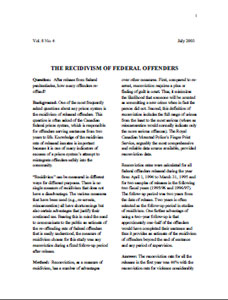
|
The recidivism of federal offenders
|
After release from federal penitentiaries, how many offenders re-offend?
| 2003-07-01 |

|
Psychological deviance among child molesters
|
Does psychological deviance predict the recidivism of child molesters?
| 2003-05-01 |

|
The content of sexual offender risk scales
|
How can we improve risk scales for sexual offenders?
| 2003-03-01 |

|
The Reconviction Rate of Federal Offenders 2003-02
|
The present study was conducted as part of the mandate of the Solicitor General Portfolio Corrections Statistics Committee to provide the general public and professionals basic statistical information on corrections and conditional release.
| 2003-02-01 |

|
Restorative justice and recidivism
|
Can restorative justice programs influence offender recidivism?
| 2003-01-01 |

|
Notes on the development of Static-2002 2003-01
|
This paper describes the development of a new risk scale for sexual offenders, Static-2002.
| 2003-01-01 |
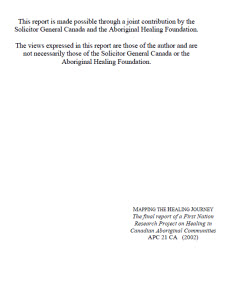
|
Mapping The Healing Journey
|
The final report of a First Nation Research Project on Healing in Canadian Aboriginal Communities
| 2002-12-01 |

|
Choices and consequences - Offenders as a Resource For Crime Prevention
|
What follows is a collection of thoughts on the topic of how Aboriginal offenders may offer their talents to keep young people from coming into conflict with the justice system. It includes background work that has been done in this area as well as descriptions of some fine programs that no longer exist and one that continues.
| 2002-12-01 |

|
Guidelines for offender risk assessment
|
How does the research literature offer to guide the selection and use of offender risk assessment instruments?
| 2002-11-01 |

|
Restorative justice: promising beginnings
|
What do we know about the impact of restorative justice programs in Canada?
| 2002-09-01 |

|
The effectiveness of treatment for sexual offenders
|
Does treatment keep sexual offenders from reoffending?
| 2002-07-01 |

|
The effects of punishment on recidivism
|
Does punishment of offenders reduce their re-offending?
| 2002-05-01 |

|
Offender risk assessments: Approaches to their development
|
How do researchers approach the development of offender risk scales?
| 2002-03-01 |
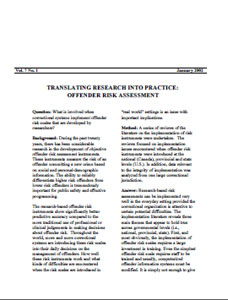
|
Translating research into practice: Offender Risk Assessment
|
What is involved when correctional systems implement offender risk scales that are developed by researchers?
| 2002-01-01 |
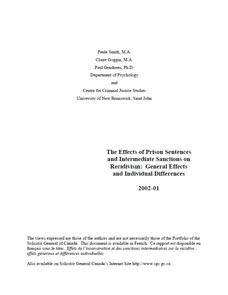
|
The Effects of Prison Sentences and Intermediate Sanctions on Recidivism: General Effects and Individual Differences
|
The purpose of this investigation was to update the results from these previous reports and to examine the effects of sanctions for juveniles, females, and minority groups.
| 2002-01-01 |

|
A Cost-Benefit Analysis of Hollow Water's Community Holistic Circle Healing Process
|
A Cost-Benefit Analysis of Hollow Water's Community Holistic Circle Healing Process
| 2001-12-01 |

|
Public fear of crime and perceptions of the criminal justice system: A review of recent trends
|
How does fear of crime relate to attitudes toward the criminal justice system?
| 2001-11-01 |
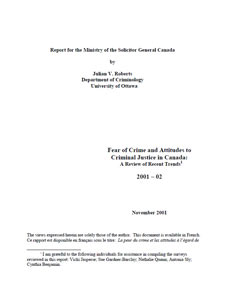
|
Fear of Crime and Attitudes to Criminal Justice in Canada: A Review of Recent Trends 2001-02
|
This report summarizes recent trends with respect to fear of crime and attitudes to criminal justice in Canada.
| 2001-11-01 |
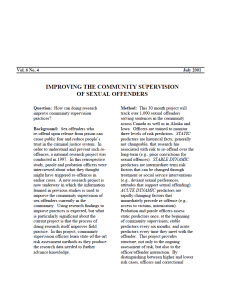
|
Improving the community supervision of sexual offenders
|
How can doing research improve community supervision practices?
| 2001-07-01 |

|
National Consultation with Victims of Crime
|
In this report, I am pleased to present the main issues raised during a recent national consultation with victims of crime.
| 2001-07-01 |

|
Age and sexual recidivism
|
Does the risk of sexual offending decrease with age?
| 2001-05-01 |

|
High-Risk Offenders - A Handbook for Criminal Justice Professionals
|
This handbook describes the principal legislative and policy options developed by the Government of Canada and available to members of Canada's criminal justice system for dealing with High-Risk offenders.
| 2001-05-01 |

|
A statistical overview of federal corrections and conditional releases
|
What is the statistical picture of federal corrections and conditional release in Canada?
| 2001-03-01 |

|
Policy relevant correctional research
|
How does correctional research influence public policy?
| 2001-01-01 |
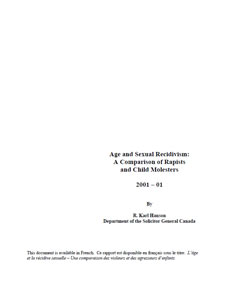
|
Age and Sexual Recidivism: A Comparison of Rapists and Child Molesters
|
This study examined the relationship of age to sexual recidivism using data from 10 follow-up studies of adult male sexual offenders (combined sample of 4,673).
| 2001-01-01 |

|
Predicting Recidivism Among Abusive Men
|
What factors are associated with continued violence among men who have abused their intimate partners?
| 2000-11-01 |

|
Treating the higher risk offender
|
Can treatment be effective with higher risk offenders?
| 2000-09-01 |
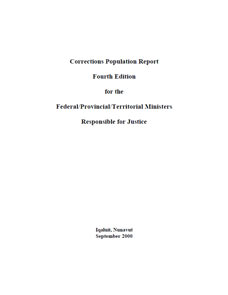
|
Corrections Population Report - Fourth Edition for the Federal/Provincial/Territorial Ministers Responsible for Justice
|
The current report is designed to conclude the series and to provide a status report on progress and developments over the past 5 years.
| 2000-09-01 |

|
Treatment for abusive men
|
What type of treatment works best with abusive men?
| 2000-07-01 |

|
Predicting Recidivism Among Male Batterers
|
The present study examined recidivism risk factors in a sample of 320 male batterers.
| 2000-06-01 |

|
Adolescent female aggression
|
Is the aggression of adolescent girls different from the aggression of adolescent boys?
| 2000-05-01 |

|
A Multi-Site Study of Treatment for Abusive Men 2000-05
|
This study examined the relative effectiveness of four treatment programs for abusive men (n = 230).
| 2000-05-01 |

|
Female Adolescent Aggression: A Review of the Literature and the Correlates of Aggression
|
This review of the literature focuses on aggression and girls.
| 2000-04-01 |

|
Pardoned sex offenders in Canada: What do we know?
|
How many sex offenders have been pardoned under the Criminal Records Act and how many reoffend sexually?
| 2000-03-01 |

|
Pardoned Offenders in Canada: A Statistical Analysis 2000-02
|
Pardoned Offenders in Canada: A Statistical Analysis 2000-02
| 2000-03-01 |

|
Measuring the change in risk posed by sex offenders
|
How can we evaluate changes in risk levels for sex offenders?
| 2000-01-01 |

|
The Sex Offender Need Assessment Rating (SONAR): A Method for Measuring Change in Risk Levels 2000-1
|
The current study examines how well the dynamic risk factors identified in the Hanson and Harris (1998) study can be organised into a structured risk assessment.
| 2000-01-01 |

|
The effect of prison on criminal behavior
|
Does increasing the length of time in prison reduce the criminal behaviour of offenders?
| 1999-11-01 |

|
Brief risk scales for the prediction of sex offence recidivism
|
How well can brief, structured risk scales predict sex offence recidivism?
| 1999-11-01 |

|
Corrections research in Canada: Taking stock
|
What have been the most significant developments in corrections research in Canada during the past twenty years?
| 1999-07-01 |

|
The electronic monitoring of offenders
|
Does electronic monitoring reduce the criminal behaviour of offenders?
| 1999-05-01 |

|
Electronic Monitoring in Canada
|
The present evaluation not only used comparison groups of inmates and probationers, but also introduced controls for offender risk. Thus, we were in a position to investigate the impact of EM, and treatment, on offender recidivism.
| 1999-05-01 |
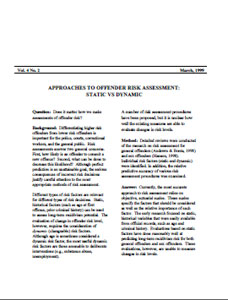
|
Approaches to offender risk assessment: static vs dynamic
|
Does it matter how we make assessments of offender risk?
| 1999-03-01 |
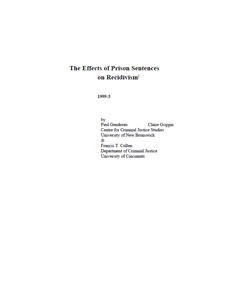
|
The Effects of Prison Sentences on Recidivism
|
The Effects of Prison Sentences on Recidivism
| 1999-03-01 |

|
Static 99: Improving Actuarial Risk Assessments for Sex Offenders
|
The purpose of the present study was to compare the predictive accuracy of two of these actuarial schemes: the RRASOR (Hanson, 1997) and the SACJ (see Grubin, 1998).
| 1999-02-01 |

|
Measuring the extent of crime
|
Is crime on the increase?
| 1999-01-01 |

|
Restorative justice: An alternative to traditional criminal justice
|
Can restorative justice offer a practical alternative to traditional criminal justice processing?
| 1998-11-01 |
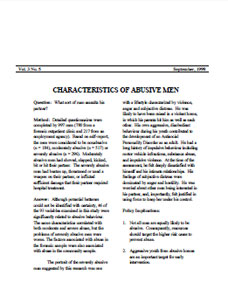
|
Characteristics of abusive men
|
What sort of man assaults his partner?
| 1998-09-01 |

|
Triggers of sexual offence recidivism
|
When are sexual offenders are at risk to re-offend?
| 1998-07-01 |

|
Mentally disordered offenders
|
How dangerous are mentally disordered offenders?
| 1998-05-01 |

|
Assessing the risk of re-offending among Aboriginal offenders
|
Do risk factors for recidivism differ between Aboriginal and non-Aboriginal offenders?
| 1998-03-01 |
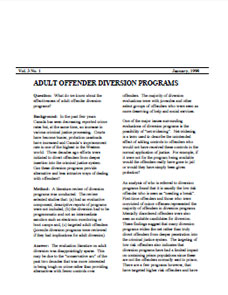
|
Adult offender diversion programs
|
What do we know about the effectiveness of adult offender diversion programs?
| 1998-01-01 |

|
Dynamic Predictors Of Sexual Recidivism
|
Carefully monitoring the risk indicators identified in this study should help officers to provide graduated and responsive interventions well before the point of no return.
| 1998-01-01 |

|
The Four Circles of Hollow Water
|
The purpose of this collection is to explore the Hollow Water experience; to see the community in the context of its culture and of Canadian society as a whole; to hear what others have to say about them, and what they have to say about themselves.
| 1997-12-01 |
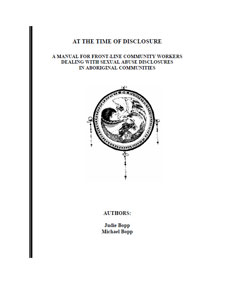
|
At the Time of Disclosure a Manual for Front-Line Community Workers Dealing with Sexual Abuse Disclosures in Aboriginal Communities
|
This manual has been developed to assist front-line community workers, especially those in aboriginal communities, deal more effectively with issues around sexual abuse disclosures.
| 1997-12-01 |

|
Female offender recidivism
|
What are the risk factors associated with female offenders' continuation in crime?
| 1997-11-01 |

|
Social networks of sexual offenders
|
Do sexual offenders know other sexual offenders?
| 1997-09-01 |

|
An alternative model for treating abusive men
|
Are there non-traditional ways of treating male batterers?
| 1997-07-01 |
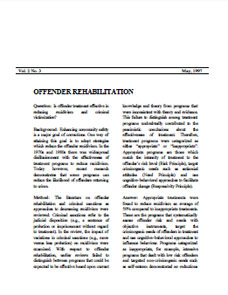
|
Offender rehabilitation
|
Is offender treatment effective in reducing recidivism and criminal victimization?
| 1997-05-01 |

|
The Development of a Brief Actuarial Risk Scale for Sexual Offense Recidivism 1997-04
|
The present study used data from seven different followup studies to develop a brief, actuarial risk scale, which was then replicated on an additional independent sample (total sample size of 2,592).
| 1997-04-01 |

|
Predicting adult offender recidivism
|
What are the best predictors of offender recidivism and, secondly, what type of actuarial measures are best suited for this purpose?
| 1997-03-01 |

|
Predictors of sex offence recidivism
|
How can we tell which sexual offenders are at high risk to re-offend?
| 1997-01-01 |

|
Offender Rehabilitation: From Research to Practice 1997-01
|
This paper attempts to translate into practice what we know from the research on effective interventions with offenders.
| 1997-01-01 |

|
Examining Aboriginal Corrections in Canada
|
This document provides information gathered though surveys, analyses of quantitative data and a review of current literature and research about the state of aboriginal corrections.
| 1996-12-01 |

|
Explaining aboriginal corrections
|
What is the state of knowledge in aboriginal corrections and what are the most critical policy and program issues?
| 1996-11-01 |

|
Dangerous offenders in Canada
|
Are the Dangerous Offender provisions of the Criminal Code of Canada actually targeting high risk violent offenders?
| 1996-09-01 |
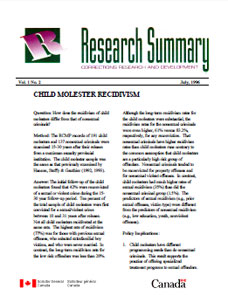
|
Child molester recidivism
|
How does the recidivism of child molesters differ from that of nonsexual criminals?
| 1996-07-01 |

|
Prediction of recidivism
|
Is the Statistical Information on Recidivism (SIR) scale still a valid measure of offender risk?
| 1996-05-01 |

|
Predictors of Sexual Offender Recidivism: a Meta-Analysis 1996-04
|
This review provides a quantitative summary of recidivism risk factors for sexual offenders.
| 1996-04-01 |
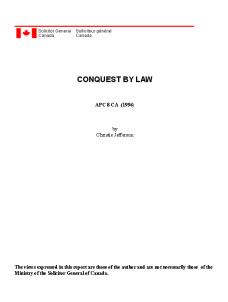
|
Conquest By Law
|
I offer the original manuscript in the spirit in which it was written: an account of the original aboriginal justice system and what happened when white men arrived with their laws and guns. It will hopefully serve as a useful reference and an account of a shameful part of Canadian history, the record of the pain and injustice that was suffered by the First Nations.
| 1994-12-01 |

|
Understanding The Role of Healing in Aboriginal Communities
|
The report attempts to develop a common understanding of "healing" among Aboriginal community members and non-Aboriginal government representatives.
| 1994-12-01 |

|
Selected Urban Aboriginal Correctional Programs In Canada: A Program Review
|
This is a descriptive report on seven selected urban Aboriginal correctional programs in Canada, chosen to provide an overview of the range of programs and services in the area.
| 1994-12-01 |

|
Community Development & Research
|
This report is the result of an intensive, two-day session held in August, 1994.
| 1994-12-01 |